Can you really earn steady profits from selling custom phone cases? It’s a valid concern that most business owners struggle with. After all, nobody wants to invest time and resources into a business that doesn’t pay off.
The truth is, the demand for unique, protective, and personalized phone cases is really growing. So, with the right designs and smart selling strategies, you capitalize on this demand and earn great profits.
This guide will reveal how much money custom cases can make. We'll break down the numbers so you can see the real profit potential.
Is a Phone Case Business Profitable?
Yes, many successful phone case businesses generate 40% margins and can even scale up to six or seven figures in revenue. With the right approach, you can achieve similar or even better results.
Here’s what the numbers show:
- The average revenue for a successful phone case business is around $1.47 million per year, according to a Starter Story report.
- Phone case profit margins often fall between 40% and 200%, as per Shopify.
- The print-on-demand (POD) model makes it easy to start selling personalized cases with very little financial risk.
Also Read:
- Phone Case Sales Statistics: Trends & Data for POD Store
- How to Sell Print on Demand on Amazon: Beginner’s Guide
How Much Money Can You Make Selling Custom Phone Cases?
Your phone case business profit depends on your sales volume, retail price, and upsell techniques. The key is understanding your costs and setting a smart pricing strategy.
For instance, a POD company like Podbase charges around €7.95 per customized cell phone case (roughly $8–$9 USD).
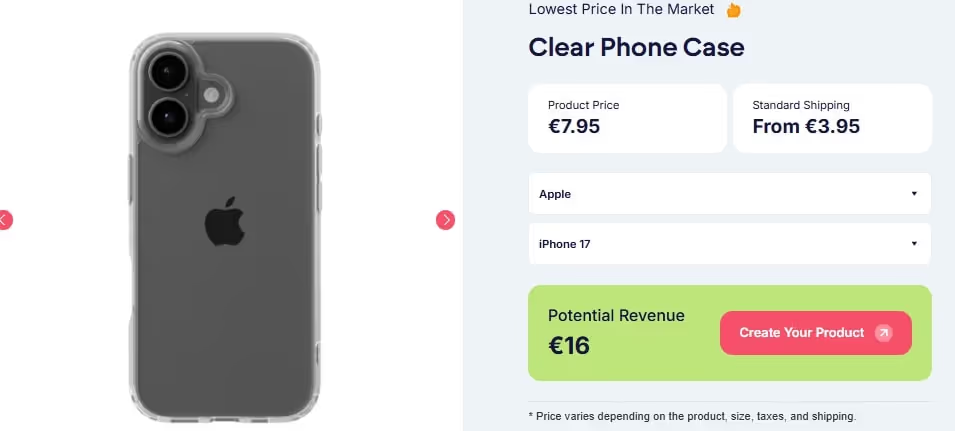
You can then sell each print-on-demand phone case at a retail price of anywhere from $20 to $35. That means you’re looking at a per-unit profit margin of $12–$25 before other expenses like shipping, marketing, and transaction fees.
Using $12 as your retail price:
- 100 sales per month = $1,200 profit
- 1,000 sales per month = $12,000 profit
You can also increase your average order value and revenue through upselling.
For example, you could offer grip rings that make holding the phone easier or charms and straps for personalization. You can also bundle matching screen protectors or accessories and charge more for the entire package.
Shopify makes it easy to upsell accessories directly in your online store. Here’s an example of a Shopify store that upsells relevant phone accessories to increase its average order value:
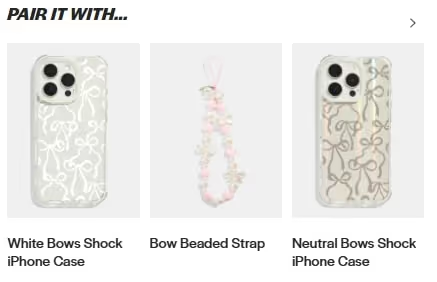
Is a Phone Case Business Worth It?
Yes, a phone case business is definitely worth your time. The market has steady demand, plenty of room for creativity, and attractive profit margins.
Here’s why the demand for phone cases stays strong:
- Phone Upgrades: On average, people replace phones every 3 years. Each upgrade means a new case purchase.
- Personalization is Trending: Customers love fashion-forward, giftable, or branded phone cases that allow them to express their unique tastes.
- Easy Shipping: Phone cases are small and lightweight, so they rarely get damaged in transit. Their lightweight nature also lowers your shipping costs.
But to truly drive sales, your phone cases must fit specific customer preferences and needs. So, how does adding a phone case increase customer satisfaction?
Apart from protecting customers’ phones from scratches and drops, it gives them something unique that matches their personality. Phone cases also make great personalized gifts for friends and family.
Also Read:
- How to Price a Product (Without Losing Profit)
- Social Media Advertising: How To Run Your First Ad Campaign
Costs You Need to Consider
While starting a print-on-demand phone case business reduces your startup costs, it still comes with some expenses. Knowing them upfront helps you price your product correctly and maximize your profit.
Here are the most common costs you’ll encounter:
Product & Fulfillment Costs
The biggest expense you’ll incur is the cost of making phone cases and delivering them to your customers. You need to plan carefully, as this directly affects your profit margins.
Here are some options to consider:
- Print-on-Demand (POD): When you partner with the best print-on-demand companies like Podbase, you don’t need to stock inventory. The POD company produces, prints, and ships your phone cases on your behalf.
You’ll only incur per-unit and shipping costs, which vary based on the case type and the customer's location.
- Bulk Ordering: Buying cases in bulk from manufacturers lowers your per-unit cost. You might pay $3–$5 per case instead of $12, which means much higher profit margins.
However, you’ll need upfront capital to buy stock, plus storage space and shipping logistics to manage orders yourself. But if you choose the POD model, you can get started without worrying about any of these costs.
- DIY Production: If you’re crafty, you can start a 3D printing business from home and create your product from scratch. But the startup cost here can be high, as you’ll need special equipment and materials to make unique cases.
Platform & Marketplace Fees
Most ecommerce platforms and marketplaces take a small percentage of your phone case sales or charge a monthly fee.
Here are some of the best ecommerce platforms, and their prices:
- Shopify: If you want to build your own online store, Shopify is an excellent pick. It gives you complete control over your brand and customer experience.
Plus, Shopify integrates easily with Podbase, allowing you to manage your designs, orders, and sales smoothly.
The platform charges a monthly subscription fee, with its basic plan starting from $27/month. Shopify also takes a small transaction fee for each sale, which varies depending on your subscription plan and payment processor.
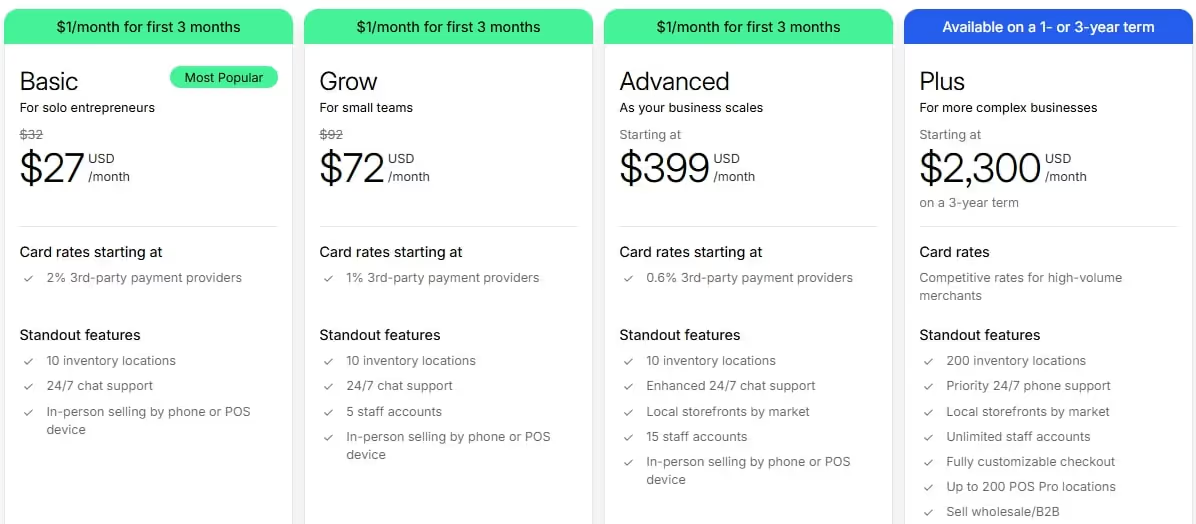
- Etsy: You can also sell Podbase POD cases on Etsy, which is ideal for handmade or custom products. It also allows you to reach a large audience of people already looking for unique items.
To sell custom phone cases on Etsy, you’ll need to pay a one-time store setup fee and a $0.20 listing fee per product. The platform also charges a 6.5% transaction fee on each sale.

Image via Etsy
Transaction Fees
It’s easy to overlook transaction fees when your main focus is selling custom phone cases. This is a common mistake that most business owners make.
Every time a customer pays for a phone case using a credit card, the payment processor takes a cut. It’s important to consider these costs, since they can add up and affect your profit margins.
PayPal and Stripe are the most popular payment gateways you can use. They charge an average of 2%–4% of the transaction amount plus a fixed $0.30 fee per sale. The exact percentage depends on the type of card used (debit, credit, or corporate).
Branding Costs
To make your custom phone cases stand out from others, you have to create a unique, memorable brand identity. Great branding makes your store look professional, builds customer trust, and encourages repeat purchases, but it comes with a price tag.
Here are some of the main branding costs you should plan for:
- Logo: Your logo is what helps customers recognize your brand, so it should be appealing and professional. You can use free design tools like Canva to create your logo.
But for the best results, consider hiring a professional designer. This will cost anywhere from $100 to $1,000.
- Packaging: Branded packaging, like custom boxes and pouches, enhances your customer’s unboxing experience and leaves a lasting impression. You can expect to spend anywhere from $0.50 to $2 per package.
- Customer Experience: Little touches, like personalized thank-you notes and stickers, can improve customer experience and encourage loyalty. These extras can cost $0.10–$0.50 per order.
Here’s a great example of a custom package with a personalized thank-you note:
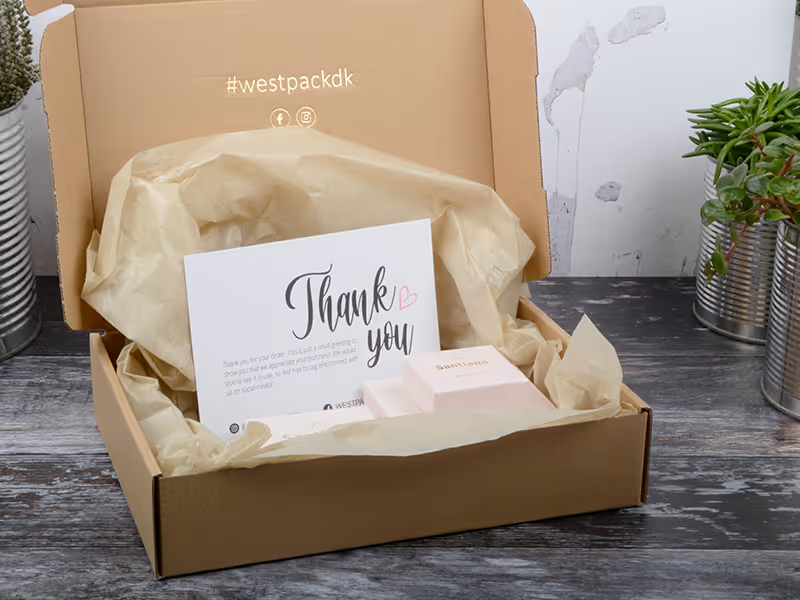
Also Read:
- Legit Ways to Make $1,000 Fast – Even With No Experience
- How to Market a Product Online (Step-by-Step Guide)
Marketing Costs
Investing in effective marketing strategies is how you ensure customers discover your custom phone cases.
Here are some common marketing costs to factor into your custom phone case pricing:
- Paid Ads: Running ads on platforms like Facebook, Instagram, or TikTok is one of the fastest ways to drive traffic to your store.
Ad costs vary, depending on the platform and competition. You can expect to spend anywhere from $0.5 to $2 per ad click.
- Influencer Marketing: You can partner with influencers who promote your custom phone cases to their audiences. Costs vary depending on the type of influencer you choose.
Here’s what to expect:
- Micro-Influencers (10k–100k followers): $200–$500 per post
- Macro-Influencers (100k–1M followers): $500–$1,000+ per post
- Mega-Influencers (1M+ followers): $10,000+ per post
- Content Marketing: Blogging, SEO, email, and social media marketing are all part of content marketing.
You can choose to create content yourself, but outsourcing to experts saves you time. Pricing varies, depending on the agency or freelancer you select.
Customer Service Costs
Excellent customer service is one of the best ways to make your customers happy and encourage repeat purchases. But it comes at an extra cost to your custom phone case business.
Here’s what to account for:
- Support Reps: As your custom phone case business grows, you may need help answering emails and questions, replying to chats, and managing returns.
Hiring virtual assistants or part-time reps may cost you $10–$20 per hour, depending on experience and location.
- Customer Service Tools: Platforms like Zendesk or Gorgias can help you manage tickets, automate responses, and provide faster service. Prices usually start from $20 to $50 per month, based on the tool.
How to Maximize Phone Case Business Profit
To maximize profits, develop a clear strategy to price your products, manage your costs, and market your business effectively.
Here are the best ways to maximize profit in your custom phone case business:
Find Your Niche
Instead of selling your print-on-demand designs and phone cases to everyone, focus on a group with specific interests or needs.
Here are some profitable POD niches to consider:
- Teens and young adults who love trendy, aesthetic, and meme-inspired designs
- Corporate branding targeting businesses that order custom phone cases in bulk
- Fandom designs for TV shows, sports teams, or fans of music groups
Choose High-Margin Case Types
Some custom phone cases offer higher profit margins than others. To maximize profit, sell high-value custom phone case types, such as:
- Wallet cases come with slots for cards and cash, which attract higher prices for convenience
- Battery cases offer built-in charging, a feature that justifies higher pricing
- Tough phone cases appeal to people who want extra durability for a premium price
Here’s an example of a tough phone case from Podbase:
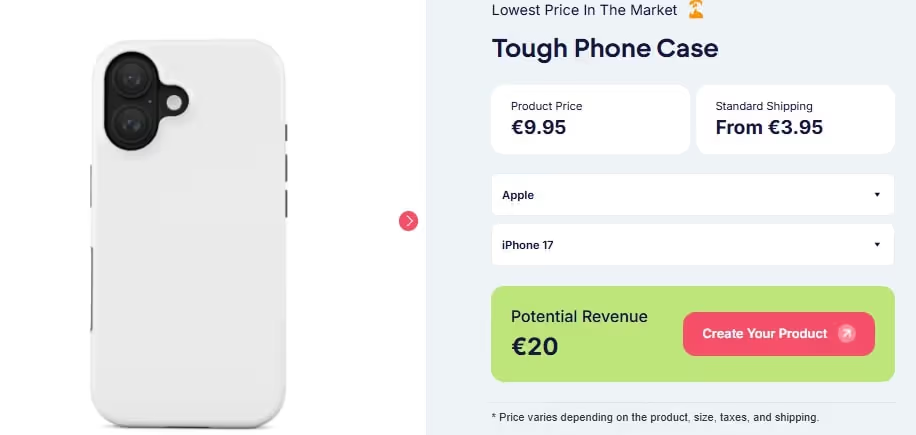
Leverage POD Platforms Like Podbase
Renting storage space, managing inventory, printing, and shipping products requires a huge investment. However, working with a print-on-demand service like Podbase offsets these startup costs, while offering you a decent margin for each sale. You can start an online store without inventory and test various phone case designs.
Here’s how Podbase POD solutions work:
- You upload your designs to Podbase
- A customer orders a custom phone case
- Podbase prints and ships it directly to the buyer
Expand to Marketplaces
Selling on one platform limits your reach. To increase your chances of making more sales, expand to multiple marketplaces.
Here are some great options:
- Etsy: The perfect place to reach customers already shopping for unique, artistic, and creative phone case designs
- Amazon: Great for showing your phone cases to a large audience and boosting visibility
- Shopify Store: Ideal for creating a unique and professional brand that attracts customers
Scale Marketing
You’ll need to scale your marketing efforts to reach more customers and maximize profits.
Here are some strategies to consider:
- TikTok Trends: Use trending sounds, challenges, or hashtags to showcase your custom phone cases in fun, engaging ways.
- Influencer Collaborations: Work with influencers who already have loyal audiences to broaden your reach, build trust, and drive sales.
- Invest in SEO (Search Engine Optimization): Use relevant keywords in your custom phone case product listings and descriptions to improve search engine visibility.
Also Read:
How Profitable is a Phone Case Business?
A custom phone case business can be incredibly profitable with the right strategy in place. The market is valued at $26.08 billion in 2025 and is expected to reach $35.24 billion by 2029.

Most successful custom phone case businesses bring in about $1.47 million per year. Many companies also report profit margins ranging from 40% to 200%. How much money custom phone cases can make also depends on the size of your business.
If you’re running a small print-on-demand side hustle, you can make anywhere between $500 and $2,000 a month. It’s a great way to earn some extra income while working full-time. An established phone case brand can make $30,000 or more in just one week and over $120,000 a month.
Summary
Selling custom phone cases is one of the best ways to earn a great income. The POD model makes it easy to get started without inventory, printing, or shipping costs.
Still, it’s important to consider startup costs like ecommerce platform fees, marketing, and branding so you can plan for growth and stay profitable.
Ready to get started? Open a free account with Podbase to turn your custom phone case designs into a profitable business!









